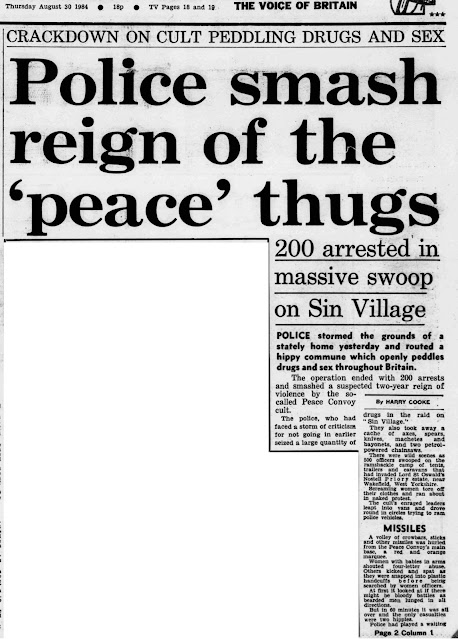Nostell Priory Music Festival was held near Wakefield in West Yorkshire in 1984, a commercial festival with performances from Van Morrison, The Band, The Damned and many others. It was also the scene of a violent police operation against the Convoy of festival travellers that prefigured the notorious
Battle of the Beanfield in the following year.
The Convoy had emerged from the UK free festival scene in the late 1970s, as a nomadic community moving between festivals in trucks, vans and converted buses. For many travelling became a way of life all year round, not just in the summer festival season with the term New Age Travellers being invented to describe them (though not generally used by the people themselves). The name 'Peace Convoy' became attached to the Convoy as the peace camps at Greenham Common and Molesworth cruise missile bases became added to the itinerary. For instance in 1982, the Convoy arrived at Greenham and occupied land for a 'Cosmic Counter-Cruise Carnival'.
Thus the Convoy was lined up in the Thatcher Government's sights as part of The Enemy Within, along with striking miners, peace campaigners, Irish republicans and other dissidents.
At Nostell Priory, as at many other festivals including Glastonbury in that period, the Convoy has established its own more anarchic area on the edge of the commercial festival. As the festival came to an end, riot police raided the site, arrested 360 travellers (almost all present) and trashed their tents, benders and vehicles. Many of them were remanded in custody for up to two weeks - including in an army prison - before being convicted by magistrates on various trumped up charges.
'It was the time of the miners’ strike, and the police had been herding them off into a field and battling it out with them. When the police steamed into Nostell Priory, they were fresh from beating up this bloody mega-wodge of miners. The first we knew of it was about half past eleven, when Alex came steaming past my gaff shouting, ‘The Old Bill’s coming up!’ As I leapt outside and looked up this huge field, there was these great big blocks of bobbies, just like the Roman epics, at least four or five hundred of them. And they came charging across the field towards us, with these batons banging on their riot shields, shouting a war cry. Oh, my goodness!
They surrounded us just right of the marquee. At that point we were well and truly sorted. As I say, they had these mega bloody riot sticks, and wagons chasing through the site running into benders. Now they didn’t know whether there was anybody in these benders, and they’d run into them at high speed, just loving the way that they exploded. The tarp and all the poles would blow out, scattering the contents all over the place'.
Interestingly in terms of what we are
beginning to find out about police infiltration of movements in this period, Phil recalls that undercover police were also active in The Convoy: 'The other thing that went down: these guys that looked just like us — there was about seven of them. They’d infiltrated us that summer and done a bloody good job. They’d been wheeling and dealing along with some of the other lads that did that kind of thing. As we’re surrounded, people are getting these lumps out of their back pockets and shoving them to one side. They were arresting us — arm up the back — and filing us out through the crowd and pushing us into the main bulk of the bobbies with the tackle'.
The following contemporary account comes from Green Anarchist magazine (Nov/Dec 1984) at the time:
'Previously the Convoy had been told by the police that there would be no trouble, as long as they moved on peacefully and got out of Yorkshire. It then seems likely, after a report that the Yorkshire police chief said that "they were powerless to act against the Convoy" that Thatcher hit the ceiling, and demanded action. Next morning at 5 am, 3 coaches and 10 van loads of riot police surrounded the camp. As the Convoy retreated to the Marquee the police trashed their vehicles, smashed windows, tearing out wiring with the excuse of looking for guns. There were no guns.
They then demanded to talk to the Convoy's leader 'Boris'. They had got that wrong too. Boris is the goose. The Convoy started quacking. But they were surrounded... [later] Back at the site, a scene of wreckage, the Convoy who had just donated to the miners, were helped by them with food and tools to mend the vans and 45 gallons of diesel, and gave their addresses for bail' (Convoy Arrested, Green Anarchist, Nov/Dec.84).
Contemporary press cuttings from the Daily Express show how the police and media worked hand in hand to demonise and attack the Convoy at Nostell Priory. First ridiculously exaggerated stories about the Convoy being some kind of heavily armed cult - 'Pop village drug and sex scandal' reports 'firearms and chainsaws were among the weapons being carried by members of a bizarre cult' (28 August 1984).
Then the next day an editorial calling for police action which they knew was already planned: 'When are the police going to do something effective about the so-called Peace Convoy? This bunch of violent anarchists and drug peddlers have been travelling from one rural estate to another causing mayhem' (29 August 1984).
Finally the very next day reporting '200 arrested in massive swoop on Sin Village' - 'Police smash the reign of the "peace thugs"... Police stormed the grounds of a stately home yesterday and routed a hippy commune which openly peddles drugs and sex throughout Britain' (Thursday 30 August 1994).
Interview with Phil the Beer of the Convoy with his account of Nostell Priory (I think this may be an extract from a film called 'Operation Solstice' made in about 1991):
[post last updated December 2024]























